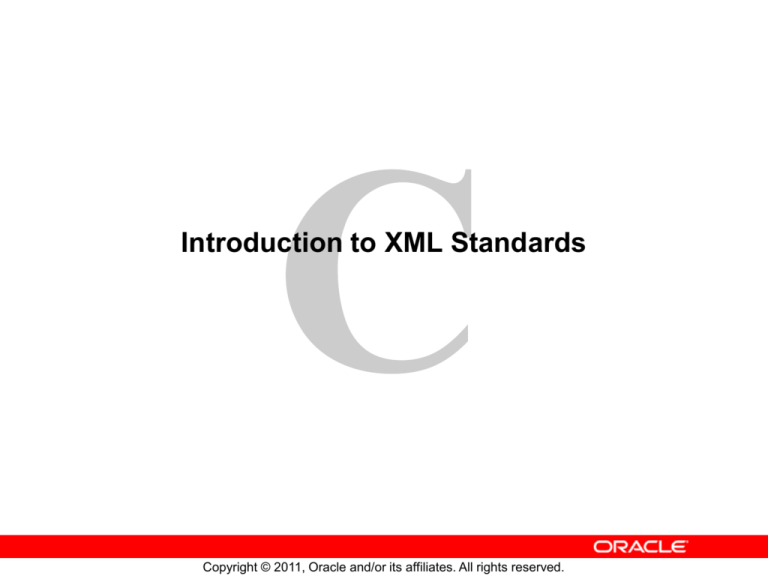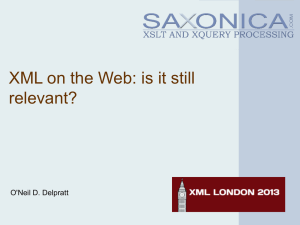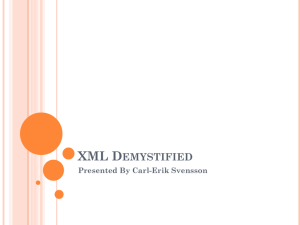
Introduction to XML Standards
Copyright © 2011, Oracle and/or its affiliates. All rights reserved.
XML Standards
Defines and
validates
Defines and
validates
2
Document Type
Definition
5
XML Schema
Locates
nodes
Uniquely identifies
elements
/Catalog/Item
4
Used by
1
XML Language
http://www.hr.com/catalog
3 XML Namespace
Applies
Transformed
to
Processed
by
6
XSL/XSLT
Stylesheet
XML Processor (DOM and SAX API)
C-2
XPath
Copyright © 2011, Oracle and/or its affiliates. All rights reserved.
Output
Document
Extensible Markup Language
Extensible Markup Language (XML) describes data objects
called XML documents that are composed of markup and data.
XML Processors
Web Data
Markup and Data
C-3
XML Document
Custom Tags
Copyright © 2011, Oracle and/or its affiliates. All rights reserved.
Advantages of Using XML
XML enables:
• A simple and extensible way to describe data
• The ability to interchange data
• Simplified business-to-business communication
• Writing of smart agents
• The ability to perform smart searches
A sample XML document:
<?xml version="1.0 encoding=“UTF-8"?>
<books>
<title>Building Oracle XML Applications</title>
<title>Oracle XML Handbook</title>
<title>Beginning XML Second Edition</title>
</books>
C-4
Copyright © 2011, Oracle and/or its affiliates. All rights reserved.
Oracle XML Support
Oracle products provide support for XML in:
• Development tools
•
Middle-tier frameworks
•
Database storage
Oracle XDK 10g
Oracle BI Publisher
C-5
Copyright © 2011, Oracle and/or its affiliates. All rights reserved.
Example: A Simple XML Page
<?xml version="1.0"?>
<employees>
<employee>
<employee_id>120</employee_id>
<last_name>Weiss</last_name>
<salary>8000</salary>
</employee>
<employee>
<employee_id>121</employee_id>
<last_name>Fripp</last_name>
<salary>8200</salary>
</employee>
</employees>
C-6
Copyright © 2011, Oracle and/or its affiliates. All rights reserved.
XML Document Structure
An XML document contains the following parts:
• Prologue
• Root element
• Epilogue
C-7
<?xml version="1.0" encoding="WINDOWS-1252"?>
<!–- this is a comment -->
<employees>
...
</employees>
1
<?gifPlayer size="100,300" ?>
3
Copyright © 2011, Oracle and/or its affiliates. All rights reserved.
2
XML Declaration
XML documents must start with an XML declaration.
The XML declaration:
• Looks like a processing instruction with the xml name, as
in the following example:
<?xml version="1.0" encoding="WINDOWS-1252"?>
<document-root>
...
</document-root>
•
Must contain the version attribute
•
May include the following elements:
– encoding attribute
– standalone attribute
•
C-8
Is optional in XML 1.0 but mandatory in XML 1.1
Copyright © 2011, Oracle and/or its affiliates. All rights reserved.
Components of an XML Document
XML documents comprise storage units containing:
• Parsed data, including the:
– Markup (elements, attributes, entities) used to describe the
data that they contain
– Character data described by markup
<?xml version="1.0" encoding="WINDOWS-1252"?>
<employees>
<employee id="100">
<name>Rachael O&apos;Leary</name>
</employee>
</employees>
•
Unparsed data, textual or binary information (graphic and
sound data), which is taken as entered
<![CDATA[
C-9
...unparsed data... ]]>
Copyright © 2011, Oracle and/or its affiliates. All rights reserved.
XML Elements
•
An XML element:
– Has a start tag, end tag, and optional data content
– Has tag names that are case-sensitive
Tag Name
<employee>
Element
Start Tag
<name>Steven King</name>
</employee>
Data
Content
End Tag
Tag Name
•
Empty elements:
– Do not contain any data
– May appear as a single tag
C - 10
<initials></initials>
<initials/>
Copyright © 2011, Oracle and/or its affiliates. All rights reserved.
Markup Rules for Elements
•
•
There is one root element, sometimes called the top-level
or document element.
All elements:
– Must have matching start and end tags, or be a self-closing
tag (an empty element)
– Can contain nested elements, so that their tags do not
overlap
– Have case-sensitive tag names subject to naming
conventions.
—
•
C - 11
Element names start with a letter, contain no spaces, and do not
start with the letters xml.
The element data content may contain a white space, such
as spaces, tabs, new lines, and combinations of these.
Copyright © 2011, Oracle and/or its affiliates. All rights reserved.
XML Attributes
An XML attribute is a name-value pair that:
• Is specified in the start tag, after the tag name
<?xml version="1.0" encoding="WINDOWS-1252"?>
<employees>
<employee id="100" name='Rachael O&apos;Leary'>
<salary>1000</salary>
</employee>
</employees>
•
•
•
C - 12
Has a case-sensitive name
Has a case-sensitive value that must be enclosed in
matching single or double quotation marks
Provides additional information about the XML document
or XML elements
Copyright © 2011, Oracle and/or its affiliates. All rights reserved.
Using Elements Versus Attributes
<?xml version="1.0"?>
<employees>
<employee>
<id>100</id>
<last_name>King</last_name>
<salary>24000</salary>
</employee>
</employees>
<?xml version="1.0"?>
<employees>
<employee id="100" last_name="King"
salary="24000">
<job>President</job>
</employee>
</employees>
C - 13
1
Elements
2
Attributes
Copyright © 2011, Oracle and/or its affiliates. All rights reserved.
XML Entities
An XML entity:
• Is a unit of data storage
• Is identified by a case-sensitive name
• Is used as replacement text (substituted) when referencing
its name between an ampersand (&) and a semicolon (;)
<comment>Salaries must not be &lt; 1000</comment>
•
Has predefined names for special XML characters:
–
–
–
–
C - 14
&lt; for less-than (<) and &gt; for greater-than (>)
&amp; for ampersand (&)
&quot; for double quotation mark (")
&apos; for single quotation mark (')
Copyright © 2011, Oracle and/or its affiliates. All rights reserved.
XML Comments
XML comments:
• Start with <!-• End with -->
•
•
•
May appear anywhere in the character data of a
document, and before the root element
Are not elements, and can occupy multiple lines
May not appear inside a tag or another comment
<?xml version="1.0" encoding="WINDOWS-1252"?>
<!–- Comment: This document has information about
employees in the company -->
<employees>
<name>Steven King</name> <!-- Full name -->
</employees>
C - 15
Copyright © 2011, Oracle and/or its affiliates. All rights reserved.
A Well-Formed XML Document
Every XML document must be well formed.
• An XML document must have one root element.
• An element must have matching start and end tag names,
unless they are empty elements.
• Elements can be nested but cannot overlap.
• All attribute values must be quoted.
• Attribute names must be unique in the start tag of an
element.
• Comments and processing instructions do not appear
inside tags.
• The special characters < and & cannot appear in the
character data of an element or attribute value.
C - 16
Copyright © 2011, Oracle and/or its affiliates. All rights reserved.
Class Activity
Identify errors in the following examples:
<?xml version="1.0"?>
<Question>Is this legal?</Question>
<Answer>No</Answer>
1
<!-- An XML document -->
<?xml version="1.0"?>
2
<Question 4You="Is this attribute name correct"/> 3
<EMAIL ID=Mark.Ant@oracle.com></EMAIL>
4
<Question>Is this legal</question>
5
C - 17
Copyright © 2011, Oracle and/or its affiliates. All rights reserved.
Comparing XML and HTML
•
XML:
–
–
–
–
–
•
HTML:
–
–
–
–
C - 18
Is a markup language for describing data
Contains user-defined markup elements
Is extensible
Is displayed as a document tree in a web browser
Conforms to rules for a well-formed document
Is a markup language for formatting data in a web browser
Contains predefined markup tags
Is not extensible
Does not conform to well-formed document rules
Copyright © 2011, Oracle and/or its affiliates. All rights reserved.
XML Development
Developing XML documents can be done using:
• A simple text editor, such as Notepad
• A specialized XML editor, such as XMLSpy
• Oracle JDeveloper 10g XML-related features that include:
–
–
–
–
C - 19
Syntax checking for XML documents
XML Editor with code insight for XML schema-driven editing
Registering of external XML schemas
Validation of XML documents against registered XML
schemas
Copyright © 2011, Oracle and/or its affiliates. All rights reserved.
XML Namespaces
An XML namespace:
• Is identified by a case-sensitive Internationalized Resource
Identifier (IRI) reference (URL or URN)
• Provides universally unique names for a collection of
names (elements and attributes)
<employee>
employee_id
<name>
<name>
department_id
<salary>
http://hr.com/employees
C - 20
<departments>
<location_id>
urn:hr:departments
Copyright © 2011, Oracle and/or its affiliates. All rights reserved.
XML Namespace Declarations: Example
<?xml version="1.0"?>
<department xmlns="urn:hr:department-ns"
xmlns:emp="urn:hr:employee-ns">
<name>Executive</name>
<emp:employee>
<emp:name>
<emp:first_name>Steven</emp:first_name>
<emp:last_name>King</emp:last_name>
</emp:name>
</emp:employee>
<emp:employee>
<emp:name>
<emp:first_name>Neena</emp:first_name>
<emp:last_name>Kochhar</emp:last_name>
</emp:name>
</emp:employee>
</department>
C - 22
Copyright © 2011, Oracle and/or its affiliates. All rights reserved.
Why Validate an XML Document?
•
•
•
•
•
C - 23
Well-formed documents satisfy XML syntax rules, and not
the business requirements about the content and structure.
Business rules often require validation of the content and
structure of a document.
XML documents must satisfy structural requirements
imposed by the business model.
A valid XML document can be reliably processed by XML
applications.
Validations can be done by using a DTD or an
XML schema.
Copyright © 2011, Oracle and/or its affiliates. All rights reserved.
Document Type Definition
A document type definition (DTD):
• Is the grammar for an XML document
• Contains the definitions of:
–
–
–
–
•
•
•
C - 24
Elements
Attributes
Entities
Notations
Contains specific instructions that the XML parser
interprets to check document validity
May be stored in a separate file (external)
May be included in the document (internal)
Copyright © 2011, Oracle and/or its affiliates. All rights reserved.
Simple DTD Declaration: Example
Example of a simple DTD with element declarations:
<!ELEMENT employees (employee)>
<!ELEMENT employee (name)>
<!ELEMENT name (#PCDATA)>
A valid XML document based on the DTD is:
<?xml version="1.0"?>
<employees>
<employee>
<name>Steven King</name>
</employee>
</employees>
Note: All child elements must be defined.
C - 25
Copyright © 2011, Oracle and/or its affiliates. All rights reserved.
XML Schema
An XML schema:
• Uses an XML language that defines and validates
the structure of XML documents
• Is stored in an XML
Validates
Schema Definition (XSD) document
• Defines components, such as:
–
–
–
–
•
C - 26
Simple types definitions
Complex type definitions
Element declarations
Attribute declarations
References
Supports XML namespaces and built-in,
simple, and complex data types
Copyright © 2011, Oracle and/or its affiliates. All rights reserved.
Instance
XML Schema Document: Example
•
A simple XML schema uses:
– A required XML namespace string, with an xs prefix,
http://www.w3.org/2001/XMLSchema
– The <schema> element as its document root
– The <element> element to declare an element
<?xml version="1.0"?>
<xs:schema
xmlns:xs="http://www.w3.org/2001/XMLSchema">
<xs:element name="departments" type="xs:string"/>
</xs:schema>
•
A valid XML instance document:
<?xml version="1.0"?>
<!-- The element cannot contain child elements -->
<departments>
Finance
</departments>
C - 28
Copyright © 2011, Oracle and/or its affiliates. All rights reserved.
XML Schema Versus DTD
•
XML schema:
–
–
–
–
–
•
Is more powerful and flexible than a DTD
Provides better namespace support than a DTD
Is written in XML syntax
Is extensible
Provides data-type support
DTD:
– Provides the ENTITY functionality that is not supported by
XML schemas
– Can be embedded in an XML document
– Is written in Standard Generalized Markup Language
(SGML)
C - 29
Copyright © 2011, Oracle and/or its affiliates. All rights reserved.
XML Path Language
XML Path Language (XPath):
• Is primarily used to address the nodes of an XML
document modeled as a tree of nodes
• Is named after its use of a path notation for navigating
through the hierarchical structure of an XML document
• Uses a compact, non-XML syntax to form expressions for
use in Uniform Resource Identifier (URI) and XML attribute
values
• Fully supports XML namespaces
• Is designed to be used by XML applications, such as XSLT
and XPointer
C - 30
Copyright © 2011, Oracle and/or its affiliates. All rights reserved.
XPath Model
Document root
1
<departments>
2
<department>
num="1"
4
<department_id>
10
3
<department_name>
Administration
<department>
C - 31
num="2"
Copyright © 2011, Oracle and/or its affiliates. All rights reserved.
5
XSLT and XPath
XSLT:
• Transforms XML into plain text, HTML, or XML
• Specifies transformation rules in elements with attributes
that use XPath expressions
<?xml version="1.0"?>
<xsl:stylesheet version="1.0"
xmlns:xsl="http://www.w3.org/1999/XSL/Transform">
<xsl:template match="//department_name">
<html>
<body>
<p><xsl:value-of select="."/></p>
<xsl:apply-templates/>
</body>
</html>
</xsl:template>
<xsl:template match="*/text()"/>
</xsl:stylesheet>
C - 32
Copyright © 2011, Oracle and/or its affiliates. All rights reserved.
XSL
Extensible Stylesheet Language (XSL) has two parts:
• XSL Transformations (XSLT)
• XSL Formatting Objects (XSL-FO)
XSL
C - 33
Copyright © 2011, Oracle and/or its affiliates. All rights reserved.
XSLT
Input XML
Document
XSL
Processor
Output XML
Document
XSL
Stylesheet
<?xml version="1.0"?>
<xsl:stylesheet ...>
<xsl:template match="XPath"/>
<!-- output information -->
Matching
</xsl:template>
Rule
</xsl:stylesheet>
C - 34
Copyright © 2011, Oracle and/or its affiliates. All rights reserved.
Output
Data
XSLT Stylesheet
An XSLT stylesheet is an XML document containing:
• A <xsl:stylesheet> root element declaring:
– The xsl namespace prefix
– The http://www.w3.org/1999/XSL/Transform
mandatory namespace URI
•
One or more <xsl:template> elements and other XSL
elements defining transformation rules
<?xml version="1.0"?>
<xsl:stylesheet version="1.0"
xmlns:xsl="http://www.w3.org/1999/XSL/Transform">
...
<xsl:template match="/"> ... </xsl:template>
<xsl:template match="..."> ... </xsl:template>
<xsl:stylesheet>
C - 35
Copyright © 2011, Oracle and/or its affiliates. All rights reserved.
XSLT Stylesheet: Example
<?xml version="1.0"?>
<xsl:stylesheet version ="1.0"
xmlns:xsl="http://www.w3.org/1999/XSL/Transform">
<xsl:template match="/">
<html>
<body>
<table border="1">
<tr><th>Id</th><th>Name</th><th>Salary</th></tr>
<xsl:apply-templates/>
</table>
5
</body>
4
</html>
</xsl:template>
<xsl:template match="employee">
<tr>
<td><xsl:value-of select="employee_id"/></td>
<td><xsl:value-of select="last_name"/></td>
<td><xsl:value-of select="salary"/></td>
</tr>
6
</xsl:template>
</xsl:stylesheet>
C - 36
Copyright © 2011, Oracle and/or its affiliates. All rights reserved.
1
2
3
Viewing the Transformed Document
Perform one of the following actions:
• Open the XML document in a web browser.
• View the oraxsl command-line processor output.
<?xml version="1.0"?>
<?xml-stylesheet type="text/xsl" href="emp.xsl"?>
<employees>
<employee>
<employee_id>100</employee_id>
<last_name>King</last_name>
<salary>24000</salary>
</employee>
<employee>
<employee_id>101</employee_id>
<last_name>Kochhar</last_name>
<salary>18000</salary>
</employee>
</employees>
C - 37
Copyright © 2011, Oracle and/or its affiliates. All rights reserved.



![[#CARBON-13743] Key store password of catalina](http://s3.studylib.net/store/data/007841975_2-b5be293be17dfbfd4fa5374476b625ea-300x300.png)




